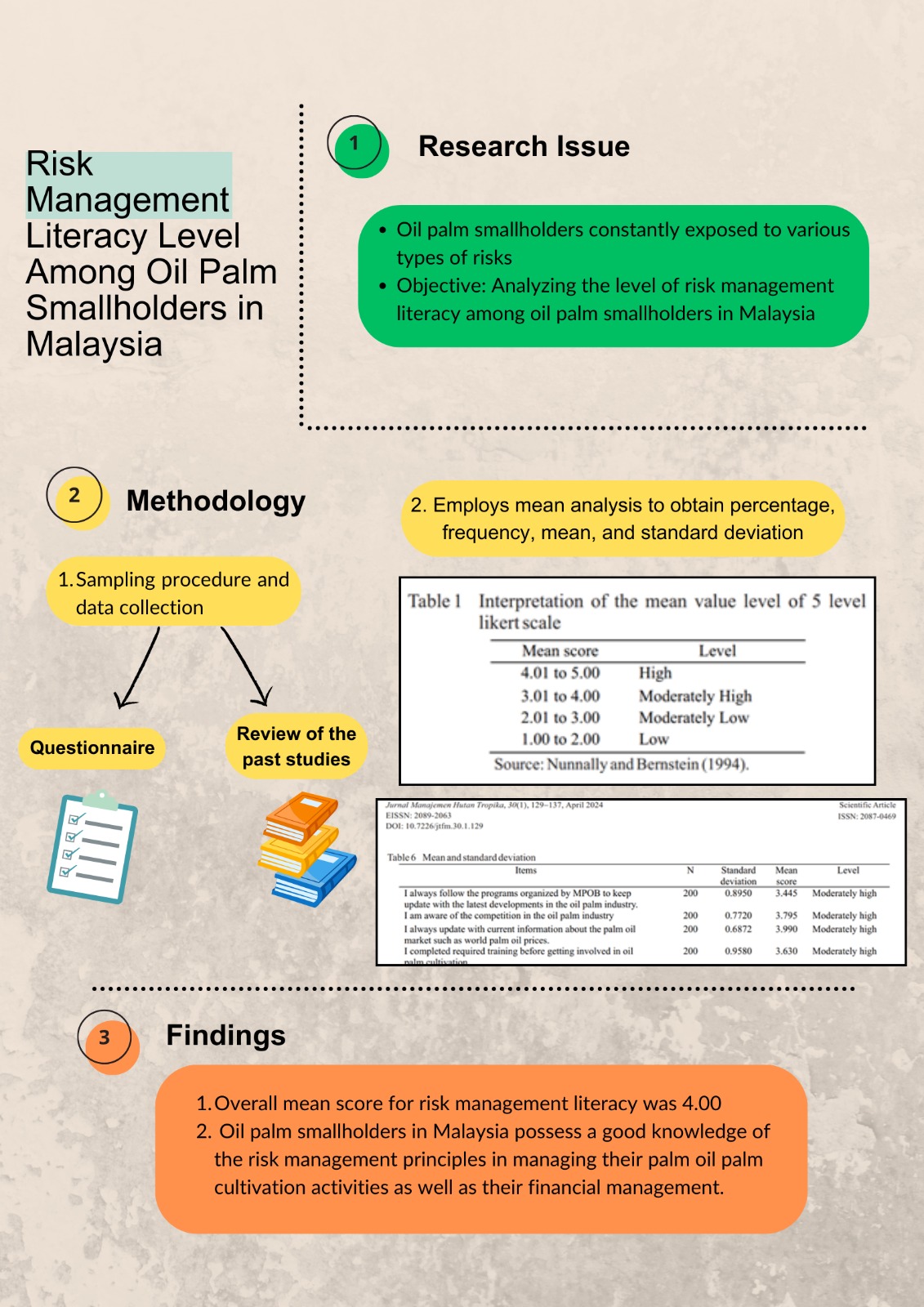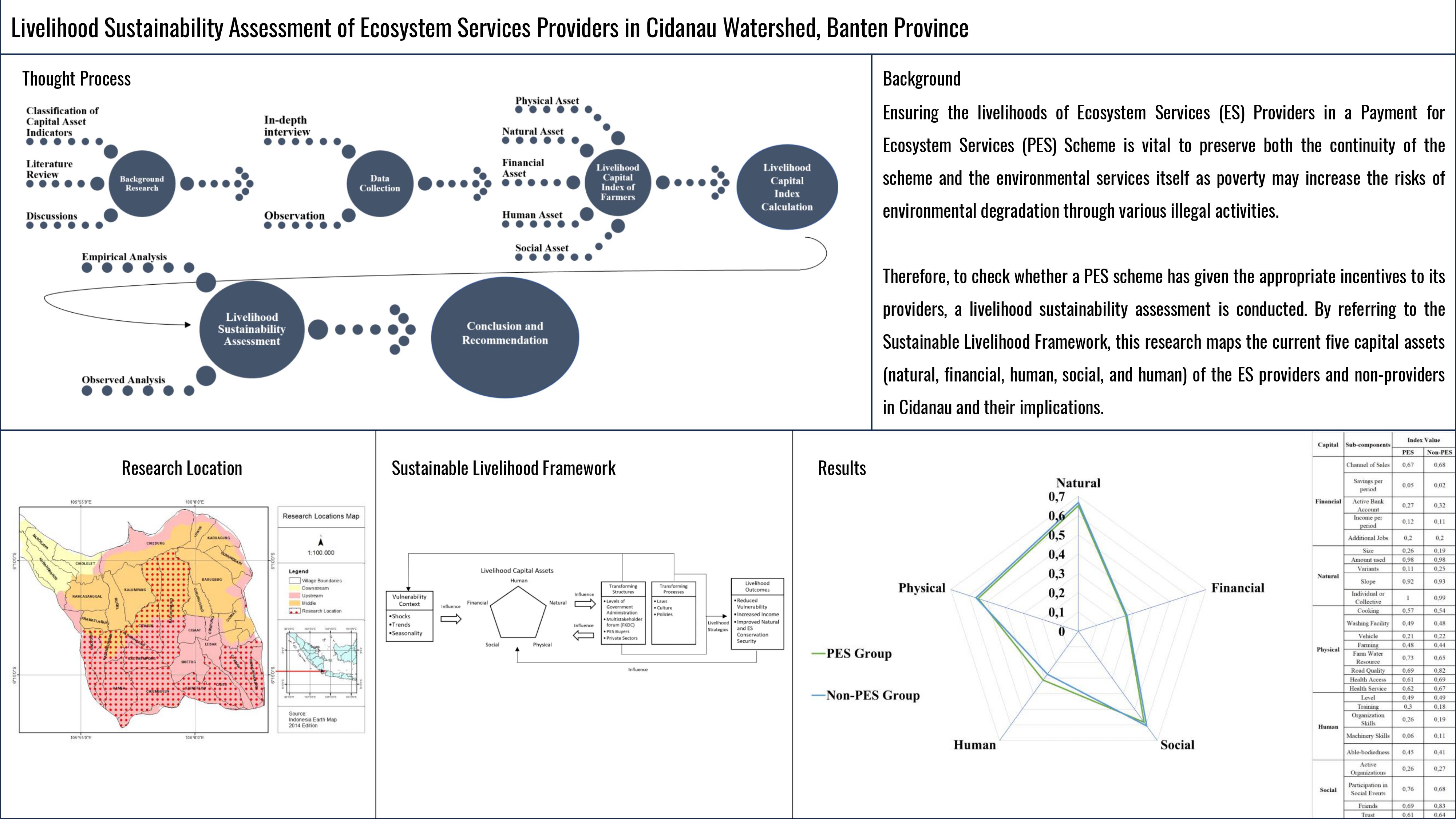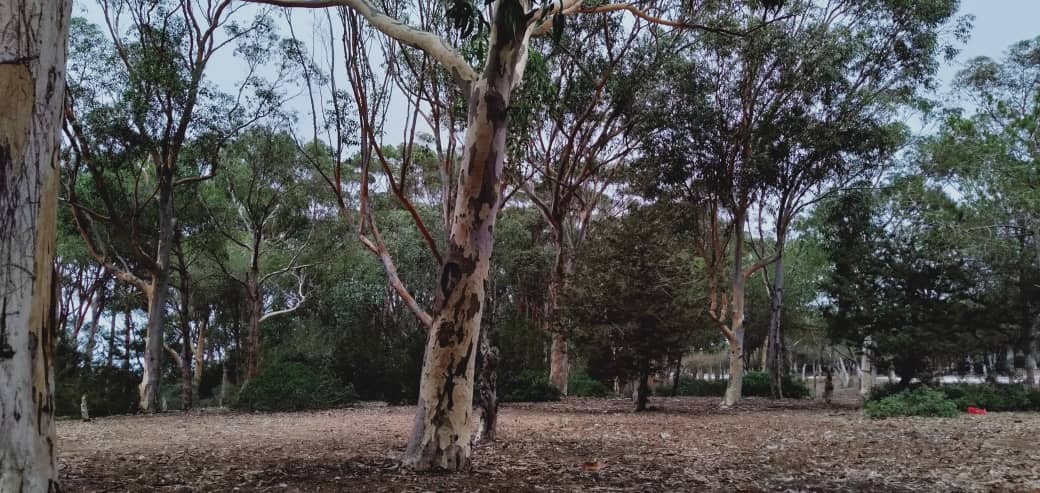Potential Criteria to Determine a Waqf-Based Forest Location Case Study: Bogor Waqf Forest, Bogor, Indonesia
Abstract
Waqf-based forests can conserve the forest ecosystem by applying waqf principles. This initiative has been implemented in several places in Indonesia. The limited funds available for waqf-based forest development require nazhir to carefully choose the best location so that the asset can function optimally. However, no specific research has been conducted to guide the selection of the best location for this purpose. This study aimed to identify potential criteria to help determine the best site for developing a waqf-based forest. Several methods were used to collect the necessary data, including literature reviews, in-depth interviews, field observations, and focus group discussions. This study identifies four crucial criteria when selecting the best locations: a) legal, b) physical and biophysical, c) high conservation value and benefits, and d) management. In addition, each criterion has sub-criteria. Among all, legal issues receive the highest highlight as unresolved regulations can affect a forest's ownership and function. This study was the first to discuss these criteria. Future research should quantify the criteria suggested using GIS and conduct more field observations in existing waqf-based forests in Indonesia.
References
Alghamdi, M. (2014). Deforestation and the Islamic stewardship ethic [thesis]. Rochester Institute of Technology. Retrieved from https://repository.rit.edu/theses/7937
Ali, K. M. (2019). Hutan wakaf: Solusi melestarikan rimba. Forest Digest, 12, 54–55.
Ali, K. M. (2020a, February 21). Hutan wakaf: Hutan abadi penyelamat bumi [Webinar]. Agri Qur’an. https://www.instagram.com/p/B8v7THAAlsp/?utm_source=ig_web_copy_link&igsh=MzRlODBiNWFlZA==
Ali, K. M. (2020b, October 16). Potret sejarah dan latar belakang hutan wakaf [Webinar]. Forest Watch Indonesia. https://fwi.or.id/sdm_downloads/ngaso-hutan-wakaf-khalifah-muhamad-ali-shut-msi/
Ali, K. M., & Kassim, S. (2020). Waqf forest: How waqf can play a role in forest preservation and SDGs achievement? ETIKONOMI, 19(2), 349–364. https://doi.org/10.15408/etk.v19i2.16310
Ali, K. M., & Kassim, S. (2021). Development of waqf forest in Indonesia: The SWOT-ANP analysis of Bogor waqf forest program by Bogor Waqf Forest Foundation. Jurnal Manajemen Hutan Tropika, 27(2), 89–99. https://doi.org/10.7226/jtfm.27.2.88
Alisjahbana, A. S., & Busch, J. M. (2017). Forestry, forest fires, and climate change in Indonesia. Bulletin of Indonesian Economic Studies, 53(2), 111–136. https://doi.org/10.1080/00074918.2017.1365404
Almuin, N., & Fauzia, F. (2021). Productive waqf land in the zoning area. International Journal of Islamic Economics, 3(2), 137. https://doi.org/10.32332/ijie.v3i2.4080
Arsyad, S. (2010). Konservasi tanah dan air (2nd ed.). Bogor: IPB Press.
Azhar. (2020, September 24). Inisiatif konservasi hutan wakaf. [Webinar]. Ecomasjid, LPLH-MUI. https://www.youtube.com/watch?v=t0yRYpr-6SA
[BAZNAS] Badan Amil Zakat Nasional. (2017). Indeks desa zakat. Jakarta: Pusat Kajian Strategis Badan Amil Zakat Nasional.
Beik, I. (2020, June 27). Zakat dan wakaf untuk pemberdayaan masyarakat sekitar hutan [Webinar]. Komunitas Hutan Wakaf Bogor. https://youtu.be/SWOUgBNatwI
Bowyer, J., Bratkovich, S., Frank, M., Fernholz, K., Howe, J., & Stai, S. (2011). Managing forests for carbon mitigation. Dovetail Partners, Inc.
Boyce, C., & Neale, P. (2006). Conducting in-depth interviews: A guide for designing and conducting in-depth interviews. Pathfinder International.
[BSN] Badan Standardisasi Nasional Indonesia. (2010). Klasifikasi penutup lahan. SNI 7645:2010. Jakarta: Badan Standardisasi Nasional.
Budiman, M. A. (2011, March 26-28). The role of waqf for environmental protection in Indonesia [Conference proceedings]. Aceh Development International Conference 2011. Universiti Kebangsaan Malaysia, Bangi, Malaysia.
Butler, R. A. (2019, April 1). Consequences of deforestation. Mongabay. https://rainforests.mongabay.com/09-consequences-of-deforestation.html
[CAF] Charities Aid Foundation. (2018). CAF world giving index 2018. https://www.cafonline.org/docs/default-source/about-us-publications/caf_wgi2018_report_webnopw_2379a_261018.pdf
Collins, S., & Larry, E. (2008). Caring for our natural assets: An ecosystem services perspective. USDA Forest Service - General Technical Report PNW-GTR (Issue 733). United States Department of Agriculture.
Diamant, J. (2019, April 1). The countries with the 10 largest Christian populations and the 10 largest Muslim populations. Pew Research Center. https://www.pewresearch.org/fact-tank/2019/04/01/the-countries-with-the-10-largest-christian-populations-and-the-10-largest-muslim-populations/
Dursun, S. (2007). Forest and the state: History of forestry and forest administration in the Ottoman Empire [dissertation]. Tuzla: Sabanci University.
Dwiyahreni, A. A., Fuad, H. A. H., Sunaryo, Soesilo, T. E. B., Margules, C., & Supriatna, J. (2021). Forest cover changes in Indonesia's terrestrial national parks between 2012 and 2017. Biodiversitas, 22(3), 1235–1242. https://doi.org/10.13057/biodiv/d220320
Farand, C. (2020, August 18). Forest destruction spiked in Indonesia during coronavirus lockdown. Climate Home News. https://www.climatechangenews.com/2020/08/18/forest-destruction-spiked-indonesia-coronavirus-lockdown/
Garg, T. (2019). Ecosystems and human health: The local benefits of forest cover in Indonesia. Journal of Environmental Economics and Management, 98, 102271. https://doi.org/10.1016/j.jeem.2019.102271
Gregersen, H., El Lakany, H., & Blaser, J. (2018). Forests for sustainable development: A process approach to forest sector contributions to the UN 2030 agenda for sustainable development. International Forestry Review, 19(1), 10–23. https://doi.org/10.1505/146554817822407349
Handoko, C. (2014). Some problems in maintaining sustainability of Indonesia's forests: Descriptive study. Indonesian Journal of Forestry Research, 1(1), 33–46. https://doi.org/10.20886/ijfr.2014.1.1.33-46
Hasanah, I., & Hakim, R. (2017, April 29). Pelestarian hutan kota melalui optimalisasi wakaf tunai [Conference presentation]. Seminar Nasional III tahun 2017: Biologi, Pembelajaran, dan Lingkungan Hidup Perspektif Indisipliner. Universitas Muhammadiyah Malang, Jawa Timur, Indonesia.
Herman, K. (2018, January 3). Puji kinerja Siti Nurbaya, Komisi VII: Tidak mudah jadi Menteri LHK. Kementerian Lingkungan Hidup dan Kehutanan. https://ppid.menlhk.go.id/berita/siaran-pers/3972/puji-kinerja-siti-nurbaya-komisi-vii-tidak-mudah-jadi-menteri-lhk
Hörnsten, L. (2000). Outdoor recreation in Swedish forests-Implication for society and forestry [dissertation]. Silvestria: ActaUniversitatis Agriculturae Sueciae.
Ibrahim, A. (2014). Stagnansi perwakafan di Aceh: Analisis faktor penyebab. Media Syariah, 16(1), 371–388. https://doi.org/10.22373/jms.v16i2.1750
Jannah, M., Ali, K. M., Fatria, B. L., Sarkawi, A. A., & Othman, J. (2021). Enhancing waqf forest sustainability through agroforestry: Case study from Bogor Waqf Forest, Bogor, Indonesia. Islam Realitas, 7(1). https://doi.org/10.30983/islam_realitas.v7i1.4454
Jannah, M., Sarkawi, A. A., & Othman, J. (2020). Legalization of waqf forests in Indonesia: The registration process. Indonesia Law Review, 10(3). https://doi.org/10.15742/ilrev.v10n3.629
Kahf, M. (2003, January 7). The role of waqf in improving the ummah welfare [Paper presentation]. The International Seminar on Waqf as a Private Legal Body, Medan, Indonesia.
Kahf, M. (2008). Role of zakah and awqaf in reducing poverty: A proposed institutional setting within the spirit of shari'ah. Thoughts on Economics, 18(3), 40–67.
Lawrence, D., Coe, M., Walker, W., Verchot, L., & Vandecar, K. (2022). The unseen effects of deforestation: Biophysical effects on climate. Frontiers in Forests and Global Change, 5, 756115. https://doi.org/10.3389/ffgc.2022.756115
Margono, B. A., Usman, A. B., Budiharto, & Sugardiman, R. A. (2016). Indonesia's forest resource monitoring. Indonesian Journal of Geography, 48(1), 7–21. https://doi.org/10.22146/ijg.12496
Marusakova, L., & Sallmannshofer, M. (Eds.). (2019). Human health and sustainable forest management. Forest Europe. https://foresteurope.org/wp-content/uploads/2017/08/Forest_book_final_WEBpdf.pdf
Permana, F. E. (2020, August 30). Kemenag dukung inovasi hutan wakaf. Republika. https://khazanah.republika.co.id/berita/qfvnr5327/kemenag-dukung-inovasi-hutan-wakaf
Phys. (2013, March 28). Half of Indonesians at risk of landslides. Phys. https://phys.org/news/2013-03-indonesians-landslides.html
Poushter, J., & Fetterolf, J. (2019, April 22). A changing world: Global vews on diversity, gender equality, family life and the importance of religion. Pew Research Center. https://www.pewresearch.org/global/2019/04/22/a-changing-world-global-views-on-diversity-gender-equality-family-life-and-the-importance-of-religion/
Ribot, J. C., & Peluso, N. L. (2003). A theory of access. Rural Sociology, 68(2), 153–181. https://doi.org/10.1111/j.1549-0831.2003.tb00133.x
Rusydiana, A. S., & Devi, A. (2018). Elaborating cash waqf development in Indonesia using analytic network process. International Journal of Islamic Business and Economics, 2(1), 1–13. https://doi.org/10.28918/ijibec.v2i1.1177
Setyorini, S. N., Wirdyaningsih, & Hazna, C. A. (2020). Wakaf lingkungan hidup dalam rangka pelaksanaan pembangunan berkelanjutan dan penegakan keadilan antargenerasi. Journal of Islamic Law Studies, 3(1), 98–132.
Snyder, H. (2019). Literature review as a research methodology: An overview and guidelines. Journal of Business Research, 104, 333–339. https://doi.org/10.1016/j.jbusres.2019.07.039
Somvichian-clausen, A. (2016, April 26). The important relationship between forests and water. Americanforest. https://www.americanforests.org/article/the-important-relationship-between-forests-and-water/
Tamir, C., Connaughton, A., Salazar, A. M. (2020, July 20). The global God divide. Pew Research Center. https://www.pewresearch.org/global/2020/07/20/the-global-god-divide/
Tovmasyan, G. (2017). The role of managers in organizations: Psychological aspects. Business Ethics and Leadership, 1(3), 20–26. https://doi.org/10.21272/bel.1(3).20-26.2017
Trakic, A. (2009, October 20–22). The legal and administrative analysis of waqf in Bosnia and Herzegovina [Conference presentation]. Waqf Law and Management. IIUM Endowment Fund, Kuala Lumpur, Malaysia.
van der Laan, C., Budiman, A., Verstegen, J. A., Dekker, S. C., Effendy, W., Faaij, A. P. C., Kusuma, A. D., & Verweij, P. A. (2018). Analyses of land cover change trajectories leading to tropical forest loss: Illustrated for the West Kutai and Mahakam Ulu Districts, East Kalimantan, Indonesia. Land, 7(3), 108. https://doi.org/10.3390/land7030108
Wirdyaningsih, Setyorini, S. N., Hazna, C. A., & Nurchaliza, V. (2020). Hijaunya hutanku berkahnya wakafku. Jakarta: Badan Penerbit Fakultas Hukum Universitas Indonesia.
Yaakob, A., Mahzir, N., Supaat, D. I., Zakaria, M. Z., Wook, I., & Mustafa, M. (2017). Waqf as a means of forest conservation: Alternative for Malaysia. Advanced Science Letters, 23(5), 4860–4864. https://doi.org/10.1166/asl.2017.8928
Authors

This work is licensed under a Creative Commons Attribution 4.0 International License.
Jurnal Manajemen Hutan Tropika is an open access journal which means that all contents is freely available without charge to the user or his/her institution. Users are allowed to read, download, copy, distribute, print, search, or link to the full texts of the articles in this journal without asking prior permission from the publisher or the author. This is in accordance with the Budapest Open Access Initiative (BOAI) definition of open access.








